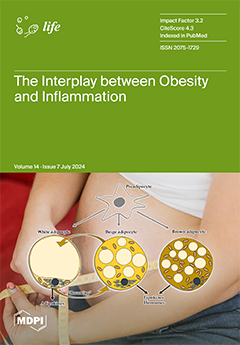To evaluate the phytochemical composition, antibacterial, and antioxidant activity of successive extracts of
Centaurea calcitrapa L. (
C. calcitrapa) aerial flowering parts, they were assessed in vitro. Using a spectrophotometer, the sample absorbance at 517 nm was used to quantify the scavenging
[...] Read more.
To evaluate the phytochemical composition, antibacterial, and antioxidant activity of successive extracts of
Centaurea calcitrapa L. (
C. calcitrapa) aerial flowering parts, they were assessed in vitro. Using a spectrophotometer, the sample absorbance at 517 nm was used to quantify the scavenging activity. The negative control was DPPH. In the current study, the diffusion using agar wells technique was adapted to measure antimicrobial activity. Phytochemical analysis was performed using the recommended standard procedures. The methanol extract of
C. calcitrapa exhibited high levels of total phenolic acids expressed as gallic acid (GA), measured as (97.25 ± 0.73 mg GAE/g) content compared to the chloroform, acetyl acetate, and aqueous extracts (27.42 ± 0.29, 64.25 ± 0.96, and 17.25 ± 0.73 mg GAE/g), respectively. Additionally, the methanol extract had a higher total tannin (27.52 ± 0.53 mg TAE/g) content compared to the chloroform, ethyl acetate, and aqueous extracts (12.02 ± 0.55, 26.01 ± 0.81, and 7.35 ± 0.56 mg TAE/g), respectively, while the aqueous extract contains a lower percentage of flavonoids (141.10 ± 1.31 mg RTE/g) compared to the higher content achieved by the methanol extract (425.93 ± 1.27 mg RTE/g). The hydroxyl groups of the flavonoid and the phenolic compounds found in
C. calcitrapa are essentially scavenging free radicals. Radical scavenging activity was highest in the methanol extract (IC50 = 2.82 μg/mL), aqueous extract (IC50 = 8.03 μg/mL), ethyl acetate extract (IC50 = 4.79 μg/mL), and chloroform extract (IC50 = 6.33 μg/mL), as compared to the standard scavenging activity (IC50 = 2.52 μg/mL). The antibacterial properties of
C. calcitrapa against Gram-negative bacterial strains
Klebsiella pneumoniae,
Escherichia coli,
Enterobacter aerogenes, and
Acinetobacter baumanii, in addition to Gram-positive strains
Staphylococcus haemolyticus,
Enterococcus faecalis, and
Staphylococcus aureus, revealed inhibition zone diameter. The findings of this investigation establish that the aerial flowering parts of
C. calcitrapa have substantial antibacterial action against human infections, and the plant can serve as a significant antioxidant that can be employed to prevent and treat severe degenerative diseases brought on by oxidative stress. qPCR showed that
C. calcitrapa extracts elevate both SOD1 and SOD2 (cellular oxidation markers) with remarkable folds (1.8-fold for SOD1 and SOD2) with ethyl acetate plant extract against ascorbic acid as a control. This result reflects that
C. calcitrapa extracts have remarkable antioxidant activity.
Full article






